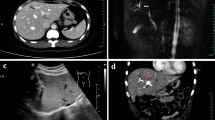Abstract
Background
Various approaches to hepatectomy have been proposed for cT2 gallbladder cancers (GBC), but the optimal management strategy remains unclear. The aim of this study is to assess the effectiveness of using an indocyanine green (ICG)-based intraoperative navigation system during hepatic resection for cT2 GBC.
Methods
From September 2007 to December 2017, 24 consecutive patients diagnosed with cT2 GBC underwent hepatic resection using ICG navigation. After cannulation of the cholecystic artery, ICG diluted with dissolution liquid was injected and ICG fluorescence illumination was visualized with the HyperEye Medical System. And additional histopathological examination was performed on the most recent 15 of the 24 patients for detection of microscopic liver metastasis.
Results
For all patients, the disease-free survival rate was 59.1% at 5 years and overall survival rate was 86.2% at 5 years. Microscopic liver metastasis was detected in the resected liver in 3 (20%) of 15 patients, whose site of liver was S6, S5, and S5, respectively. The weight of the liver resected using ICG navigation was significantly smaller than that of S4a/S5 segmentectomy (P < 0.0001).
Conclusion
Resected hepatic lesion using ICG imaging was possible to perform hepatectomy including liver micro-metastasis without excess or deficiency. This procedure might be novel intraoperative imaging method to provide valuable information on the optimal surgical approach to cT2 GBC.



Similar content being viewed by others
References
Chijiiwa K, Tanaka M (1994) Carcinoma of the gallbladder: an appraisal of surgical resection. Surgery 115:751–756
Yamaguchi K, Chijiiwa K, Saiki S, Nishihara K, Takashima M, Kawakami K et al (1997) Retrospective analysis of 70 operations for gallbladder carcinoma. Br J Surg 84:200–204
Kai M, Chijiiwa K, Ohuchida J, Nagano M, Hiyoshi M, Kondo K (2007) A curative resection improves the postoperative survival rate even in patients with advanced gallbladder carcinoma. J Gastrointest Surg 11:1025–1032
Sasaki R, Uesugi N, Itabashi H, Fujita T, Takeda Y, Hoshikawa K et al (2005) Clinicopathological study of depth of subserosal invasion in patients with pT2 gallbladder carcinoma. J Surg Oncol 92:83–88
Dong HK, Sung HK, Gi HC, Chang MK, Kyung SK, Jin SC et al (2013) Role of cholecystectomy and lymph node dissection in patients with T2 gallbladder cancer. World J Surg 37:2635–2640. https://doi.org/10.1007/s00268-013-2187-2
Sheikh MA, Osman H, Cheek S, Hunter S, Jeyarajah DR (2016) T2 gallbladder cancer—aggressive therapy is warranted. Am Surg 82:519–521
Kondo S, Nimura Y, Kamiya J, Nagino M, Kanai M, Uesaka K et al (2002) Mode of tumor spread and surgical strategy in gallbladder carcinoma. Langenbecks Arch Surg 387:222–228
Dip FD, Ishizawa T, Kokudo N, Rosenthal R (2015) Fluorescence imaging for surgeons. Springer, Switzerland
Rosenthal EL, Warram JM, de Boer E, Basilion JP, Biel MA, Bogyo M et al (2016) Successful translation of fluorescence navigation during oncologic surgery: a consensus report. J Nucl Med 57(1):144–150
Ishizawa T, Bandai Y, Ijichi M, Kokudo N (2010) Fluorescent cholangiography illuminating the biliary tree during laparoscopic cholecystectomy. Br J Surg 97:1369–1377
van der Vorst JR, Schaafsma BE, Hutteman M, Verbeek FP, Liefers GJ, Hartgrink HH et al (2013) Near-infrared fluorescence-guided resection of colorectal liver metastases. Cancer 119(18):3411–3418
Inoue Y, Arita J, Sakamoto T, Ono Y, Takahashi M, Takahashi Y et al (2015) Anatomical liver resections guided by 3-dimensional parenchymal staining using fusion indocyanine green fluorescence imaging. Ann Surg 262(1):105–111
Toh U, Iwakuma N, Mishima M, Okabe M, Nakagawa S, Akagi Y (2015) Navigation surgery for intraoperative sentinel lymph node detection using Indocyanine green (ICG) fluorescence real-time imaging in breast cancer. Breast Cancer Res Treat 153(2):337–344
Namikawa T, Uemura S, Kondo N, Yamamoto M, Maeda H, Nishimori H et al (2014) Successful preservation of the mesenteric and bowel circulation with treatment for a ruptured superior mesenteric artery aneurysm using the HyperEye Medical System. Am Surg 80(12):E359–E361
Japanese Society of Hepato-Biliary-Pancreatic Surgery (2013) General Rules for Clinical and Pathological Studies on Cancer of the Biliary Tract, 6th edn. Kanehara & Co., Ltd., Tokyo (in Japanese)
Shirai Y, Yoshida K, Tsukada K, Ohtani T, Muto T (1992) Identification of the regional lymphatic system of the gallbladder by vital staining. Br J Surg 79:659–662
Sumiyoshi K, Nagai E, Chijiiwa K, Nakayama F (1991) Pathology of carcinoma of the gallbladder. World J Surg 15:315–321. https://doi.org/10.1007/BF01658722
Kai K, Satoh S, WatanabeT Endo Y (2010) Evaluation of cholecystic venous flow using indocyanine green fluorescence angiography. JHBPS 17:147–151
Sugita M, Ryu M, Satake M, Kinoshita T, Konishi M et al (2000) Intrahepatic inflow areas of the drainage vein of the gallbladder: analysis by angio-CT. Surgery 128:417–421
Shirai Y, Tsukada K, Ohtani T, Watanabe H, Hatakeyama K (1995) Hepatic metastases from carcinoma of the gallbladder. Cancer 75:2063–2068
Ogura Y, Tabata M, Kawarada Y, Mizumoto R (1998) Effect of hepatic invasion on the choice of hepatic resection for advanced carcinoma of the gallbladder: histologic analysis of 32 surgical cases. World J Surg 22:262–267. https://doi.org/10.1007/s002689900380
Endo I, Shimada H, Takimoto A, Fujii Y, Miura Y, Sugita M et al (2004) Microscopic liver metastasis: prognostic factor for patients with pT2 gallbladder carcinoma. World J Surg 28:692–696. https://doi.org/10.1007/s00268-004-7289-4
Author information
Authors and Affiliations
Contributions
N Chiba, M Shimazu, and S Kawachi were involved in study design. N Chiba was involved in acquisition of data. Operation procedures were performed by all authors. N Chiba helped in analysis and interpretation. N Chiba contributed to drafting manuscript. N Chiba and S Kawachi helped in revision.
Corresponding author
Ethics declarations
Conflict of interest
The authors declare that they have no conflicts of interest.
Ethical approval
This research has been approved by Tokyo Medical University Hachioji Medical Center Ethics Committee.
Rights and permissions
About this article
Cite this article
Chiba, N., Shimazu, M., Ochiai, S. et al. Resection of Hepatic Lesions Perfused by the Cholecystic Vein Using Indocyanine Green Navigation in Patients with cT2 Gallbladder Cancer. World J Surg 43, 608–614 (2019). https://doi.org/10.1007/s00268-018-4810-8
Published:
Issue Date:
DOI: https://doi.org/10.1007/s00268-018-4810-8




